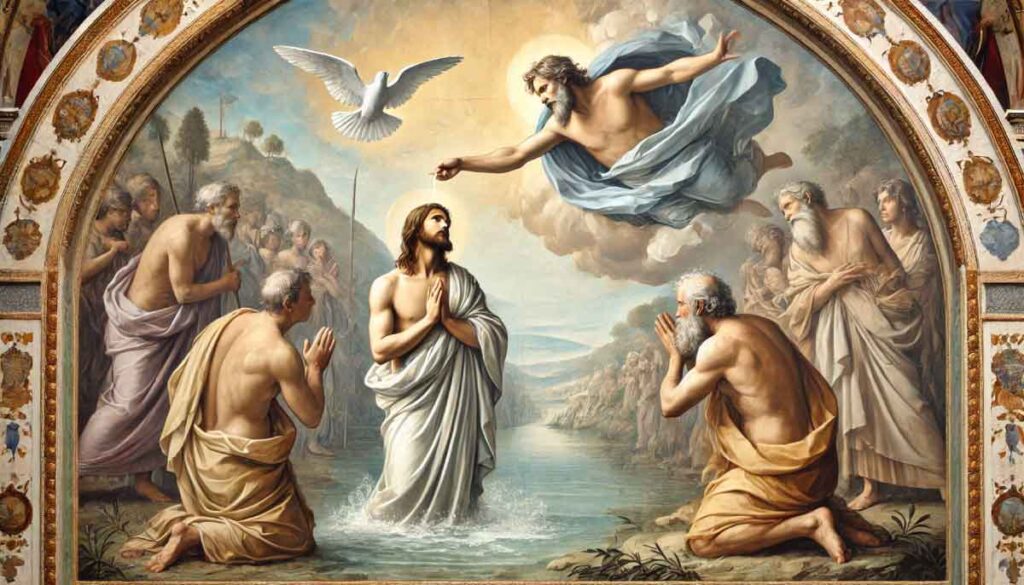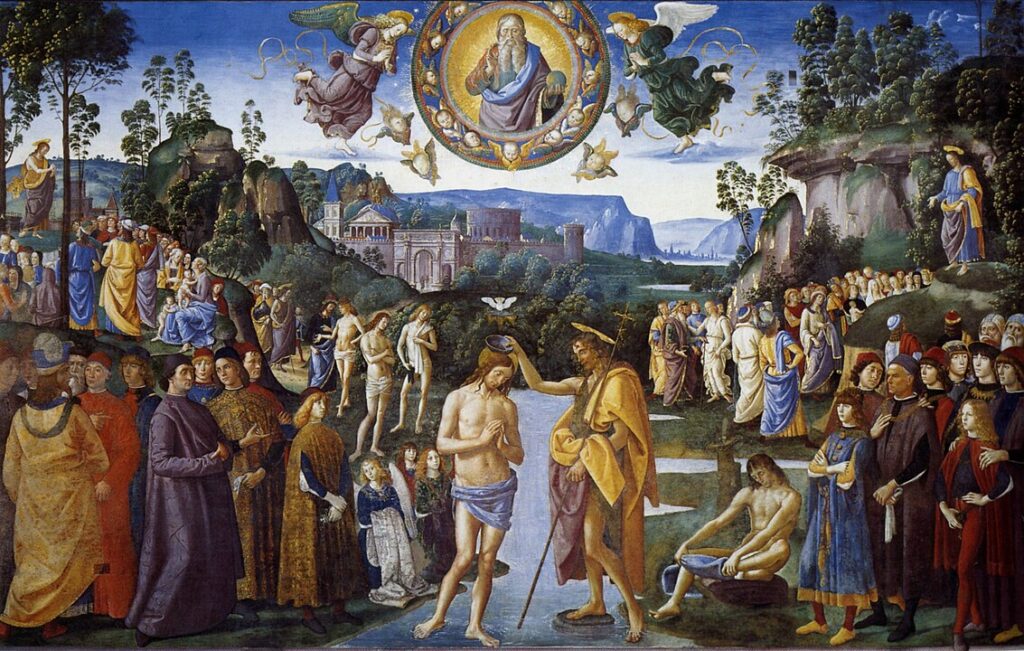From the reviews of Jesus of Nazareth by Pope Benedict XVI – Chapter List Here
Jesus’ public ministry begins with the Baptism of Jesus in the Jordan by John the Baptist. This event not only marks the start of His mission but also serves as a profound theological moment that reveals Jesus’ divine identity and mission. The Gospel accounts, particularly in Matthew and Luke, provide different contexts to this pivotal event, both linking the Baptism of Jesus to Jewish history and situating Him within the wider secular world of the Roman Empire.
The Historical Context of Jesus’ Baptism
While Matthew ties Jesus’ genealogy to Abraham and David, emphasising His role in fulfilling Jewish salvation history, Luke connects Jesus’ Baptism with the larger Roman Empire by dating it to the fifteenth year of the reign of Tiberius Caesar (Lk 3:1). This precise historical reference underscores that Jesus’ mission is not mythical but a real, historical event that affects the world at large.
Luke further emphasises that Jesus is not only a descendant of David but goes further back to Adam, symbolising that Jesus’ mission is for all humanity, not just for Israel. This places Jesus in the role of the new Adam, representing a new beginning for the human race.
John the Baptist’s Role in Preparing the Way
John the Baptist’s ministry is significant as he prepares the way for Jesus by calling the people to repentance through Baptism. John’s call for conversion was something new in the religious landscape of Judea. Unlike traditional ablutions, John’s baptism was a one-time act, symbolising a complete turning away from sin and a new direction in life.
While John’s role was to prepare for someone greater, the Baptist himself acknowledges that he did not fully know the one to come (Jn 1:30–33). His role, as prophesied in Isaiah 40:3, was to be the voice crying in the wilderness, preparing the people for God’s coming. John’s Baptism was a radical call for change and repentance, but it was still a preparation for something much greater—the coming of Jesus Christ.
Jesus’ Baptism: A Profound Act of Solidarity
When Jesus arrives at the Jordan to be baptised by John, something entirely new happens. Jesus, though sinless, chooses to be baptised alongside sinners, an act that shows His deep solidarity with humanity. This act of stepping into the waters, which symbolized confession of sin and the desire for a new life, is a profound gesture where Jesus identifies with the sin and brokenness of the world.
The mystery of Jesus’ Baptism becomes fully clear only in light of the Cross and Resurrection. As Pope Benedict XVI explains, in His Baptism, Jesus takes on the burden of humanity’s sin, symbolically descending into death, prefiguring His sacrifice on the Cross. This descent into the waters is a foretaste of Jesus’ eventual descent into the abyss of death. In this moment, Jesus takes His place as the Lamb of God, who will take away the sin of the world (Jn 1:29).
The Trinitarian Revelation at the Baptism
As Jesus emerges from the waters, heaven is opened, and the Holy Spirit descends upon Him like a dove. A voice from heaven declares, “This is my beloved Son, with whom I am well pleased” (Mt 3:17). This moment marks a significant revelation of the Trinity: the Father’s voice, the Spirit’s descent, and the Son’s presence. This Trinitarian manifestation not only affirms Jesus’ divine identity but also marks the beginning of His public ministry.
This revelation foreshadows the ultimate purpose of Jesus’ mission—His death and resurrection. The descent of the Spirit and the voice from heaven are anticipations of the Resurrection, where Jesus’ divine sonship will be fully realised. The Eastern Church emphasises this connection by associating Jesus’ Baptism with both Epiphany and Easter, seeing His descent into the waters as a symbol of His descent into Hades.
Jesus’ Baptism: Anticipation of the Cross and Resurrection
The act of Jesus’ Baptism carries deep theological significance. John’s baptism with water was an external sign of repentance, but Jesus’ baptism transforms this act into something much deeper. Through His Baptism, Jesus anticipates His Passion and Resurrection, and by submitting to this act, He sets the stage for the sacrament of Christian Baptism.
By accepting Baptism, Christians enter into the reality of Jesus’ death and resurrection, becoming participants in His sacrifice. As St. Paul teaches in Romans 6, baptism is a way of dying with Christ in order to rise with Him. The sacrament of Baptism now symbolises the same descent into death that Jesus experienced in His Baptism and the new life that follows through His Resurrection.
Jesus as the Lamb of God
At His Baptism, John the Baptist famously refers to Jesus as the Lamb of God (Jn 1:29), a title rich in Old Testament symbolism. This alludes to both the Suffering Servant of Isaiah 53, who bears the sins of the people like a lamb led to the slaughter, and the Passover lamb, whose blood saved Israel from death in Egypt. Jesus, the Lamb of God, becomes the perfect and final sacrifice for sin, offering Himself on behalf of all humanity.
This title also reflects the universal mission of Jesus. He is not only the Messiah for Israel but the Saviour of the entire world. The image of the Lamb of God signifies the depth of Jesus’ mission—to take away the sin of the world and reconcile humanity to God.
Conclusion: The Baptism of Jesus as the Foundation for Christian Baptism
The Baptism of Jesus is not just a historical event but a theological cornerstone that lays the foundation for the sacrament of Christian Baptism. Through His Baptism, Jesus takes on the sin of humanity, anticipates His death on the Cross, and sets in motion the redemptive plan of God.
The opening of heaven and the descent of the Holy Spirit at the Baptism point to the Trinitarian nature of God, while the voice of the Father confirms Jesus’ divine identity. This event reveals Jesus as the beloved Son and the Suffering Servant, who will take away the sins of the world. The Baptism of Jesus is the beginning of the end, where Jesus steps into His role as the Lamb of God who will bring salvation to all.
From the reviews of Jesus of Nazareth by Pope Benedict XVI – Chapter List Here




